Stiffening fabric is a crucial technique in the world of sewing and crafting, offering a means to transform ordinary textiles into structured and manageable materials.
Whether you’re crafting elegant garments, creating intricate accessories, or designing home decor, the process of fabric stiffening provides the essential rigidity needed to achieve precise cuts and maintain impeccable shapes.
This introductory guide explores the art of stiffening fabric, delving into various methods and their applications. From liquid starch and commercial fabric stiffeners to fusible interfacing and wireframing, each approach serves as a versatile tool in a seamstress or crafter’s arsenal.
Discover how to elevate your sewing projects to new heights of precision and professionalism by mastering the art of fabric stiffening.
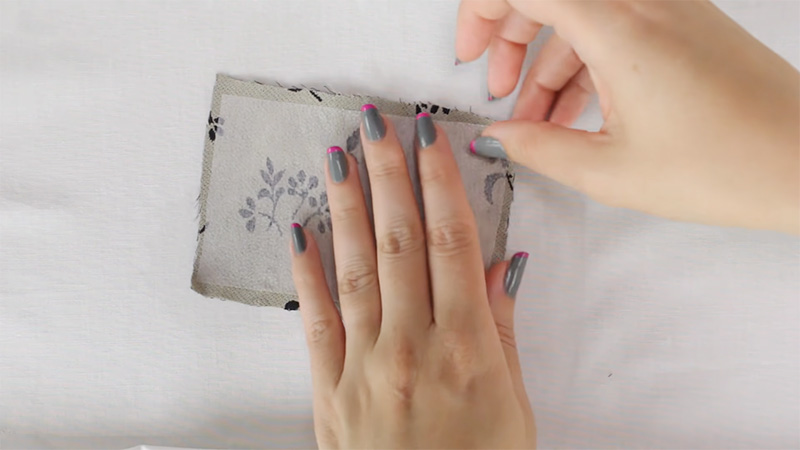
What is Fabric Stiffening?
Fabric stiffening is a process of enhancing a fabric’s rigidity and structure to make it easier to work with in sewing and crafting projects.
This is typically achieved by applying various products like liquid starch, fabric stiffener, white glue, or gelatin to the fabric, or by using sew-in or fusible interfacing.
Stiffened fabric maintains its shape, allowing for precise cutting and sewing, and is often used in projects where structure and durability are essential, such as clothing, accessories, or home decor items.
Why Do Stiffen Fabric for Sewing?
Stiffening fabric for sewing is a technique with several significant benefits and purposes.
Here’s why it’s commonly done in sewing projects:
Enhanced Structural Integrity
Stiffening fabric adds stability and rigidity, ensuring that the fabric retains its intended shape. This is especially crucial for sewing projects like garments, accessories, and home decor items that require specific forms and structures.
The stiffened fabric prevents sagging and distortion.
Improved Workability
Stiffened fabric is easier to handle during the sewing process. It minimizes issues like fraying, stretching, and bunching, which can occur when working with soft or lightweight materials.
Sewing and cutting become more precise, leading to neater and more professional results.
Durability
Stiffened fabric is more resilient and less prone to wear and tear. It can withstand regular use, washing, and exposure to various environmental factors without losing its shape or quality.
This durability ensures that the finished projects maintain their integrity over time.
Aesthetic Appeal
Fabric stiffening enhances the visual appeal of the material, giving it a polished and crisp appearance. This is particularly valuable for formal wear, costumes, and decorative items where a neat and refined finish is essential.
The stiffened fabric looks more tailored and professional.
Versatility
Stiffened fabric can be employed in a wide range of sewing projects, from clothing and accessories to home decor and crafting. It offers versatility in design and application, allowing creators to experiment with different textures, shapes, and creative possibilities.
Support for Embellishments
Stiffened fabric provides a stable foundation for adding embellishments such as embroidery, beading, appliqué, and more. The added rigidity ensures that these decorative elements remain securely attached to the fabric, enhancing the overall aesthetics of the project.
What Are the Methods of Stiffening Fabric for Sewing?
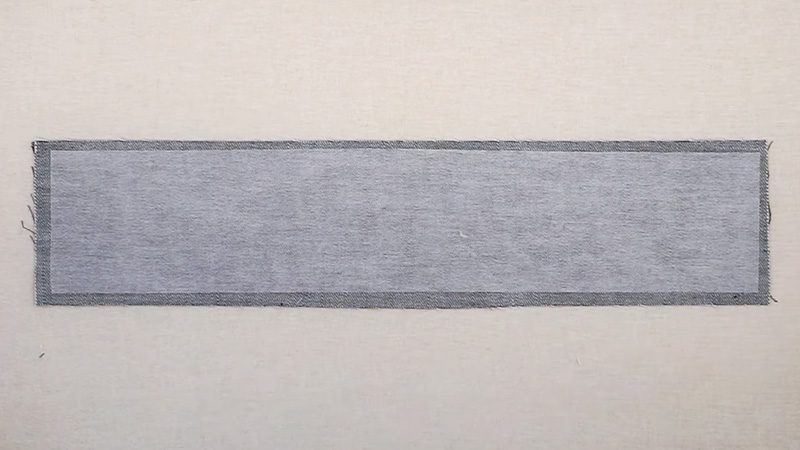
Stiffening fabric for sewing is a technique that adds structure and rigidity to the fabric, making it easier to work with and ensuring that the finished sewing project holds its shape.
There are several methods for stiffening fabric, each suited to different types of projects and fabric types. .
Here are some common methods:
Starch or Liquid Stiffeners
One common method for stiffening fabric involves using starch-based solutions or commercial liquid fabric stiffeners. If you’re making your own starch solution, you can dissolve cornstarch or potato starch in water.
The application can be done by immersing the fabric into the solution or using a spray bottle to apply it evenly. Once applied, allow the fabric to air dry.
It’s important to note that if you want to maintain the stiffness, you should avoid washing the fabric after stiffening.
Interfacing
Interfacing is a versatile method for adding stiffness to specific areas of your sewing project. It comes in various types, such as fusible (iron-on) and sew-in, and is available in different weights to suit various fabric types.
To apply interfacing, cut it to match your pattern pieces and follow the instructions for fusing it to the fabric using an iron for fusible interfacing or sewing it onto the fabric where needed.
Interfacing is commonly used for collars, cuffs, and other areas that require reinforcement.
Boning
When constructing garments like corsets, bodices, or structured dresses, boning is a favored method. Boning involves inserting rigid plastic or metal strips, aptly called “boning,” into channels sewn within the fabric.
This provides vertical support and helps maintain specific shapes and contours within the garment. To apply boning, sew channels into the fabric, insert the boning, and secure the ends.
Wire Framing
In certain crafting and costume design projects, wireframing can be employed. Flexible wire, often found in floral arrangements, can be sewn or attached along the edges of the fabric to create and sustain desired shapes or forms.
This method offers excellent flexibility in shaping. Sew the wire into the fabric, adhering to the desired pattern or design.
Adhesive Sprays
Adhesive sprays designed for fabric can temporarily add stiffness. They are applied to the fabric’s surface, allowing for shaping and manipulation before they dry and harden.
This is particularly useful when you need temporary stiffness for specific areas or projects. After applying the spray, shape the fabric as desired, knowing that the stiffness is temporary and can be altered by reapplying adhesive as needed.
Commercial Stiffening Products
In craft stores, you can find a range of commercial fabric stiffening products that are specifically formulated for the task. These products offer convenience and consistency.
Follow the instructions provided on the product label for your chosen stiffening product, as application methods and drying times may vary.
How Do You Stiffen Fabric for Sewing?
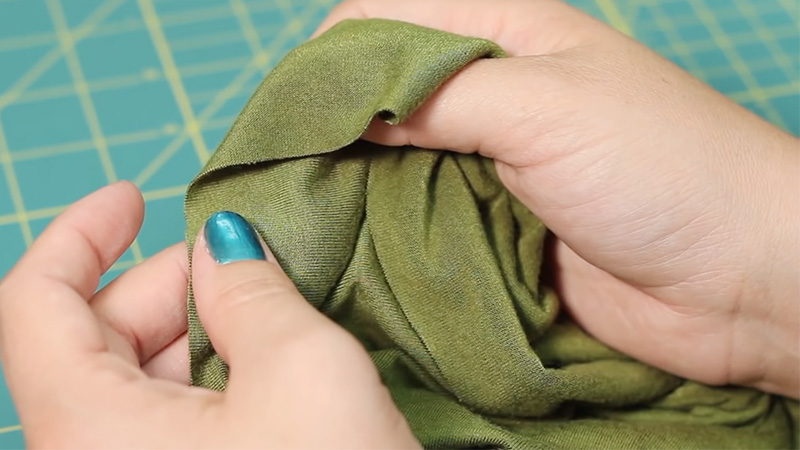
Stiffening fabric for sewing is a valuable technique that provides structure and stability to your sewing projects.
Here’s a step-by-step guide on how to stiffen fabric for sewing:
Choose Your Stiffening Method
The first step in stiffening fabric for sewing is to select the appropriate method. You can opt for liquid stiffeners like starch, fabric stiffener, white glue, or gelatin, or go for interfacing.
Your choice will depend on the type of fabric you’re working with and the stiffness level you desire for your project.
Prepare Your Workspace
Clear your workspace of any clutter and lay down protective material, such as plastic or wax paper, to catch any drips or spills. Having a clean and organized area will make the process smoother.
Dilute the Stiffener (if Using Liquid Stiffeners)
If you’ve chosen a liquid stiffener like starch or fabric stiffener, follow the instructions on the product label to dilute it with water. This step ensures that the stiffener is properly mixed and will be applied evenly to the fabric.
Apply the Stiffener
Depending on your preference and project needs, you can apply the stiffener in one of two ways. The first method involves submerging the fabric entirely in the stiffener solution, ensuring that it’s evenly coated.
Alternatively, you can use a spray bottle to lightly mist the fabric, achieving control and even application.
Allow It to Dry
After applying the stiffener, you need to allow the fabric to dry thoroughly. Hang it up or lay it flat on a clean, dry surface. The drying time can vary depending on factors like fabric type and humidity levels.
Be patient and ensure the fabric is completely dry before proceeding.
Check for Stiffness
Once the fabric is dry, assess its stiffness. Depending on your project’s requirements, you may need to repeat the stiffening process by applying additional layers of stiffener and allowing them to dry as needed.
This step ensures you achieve the desired level of rigidity.
Optional Ironing (if Needed)
If you’re using starch or interfacing and want to add more stiffness or remove wrinkles, you can gently iron the fabric on a low to medium heat setting.
Place a cloth or paper towel between the iron and the fabric to protect both surfaces.
Cut and Sew
With your fabric now suitably stiffened, you’re ready to proceed with cutting and sewing your project. The stiffened fabric will be more manageable, making it easier to work with, and it will help your sewing project maintain its desired shape.
What Are Some DIY Methods for Fabric Stiffening at Home?
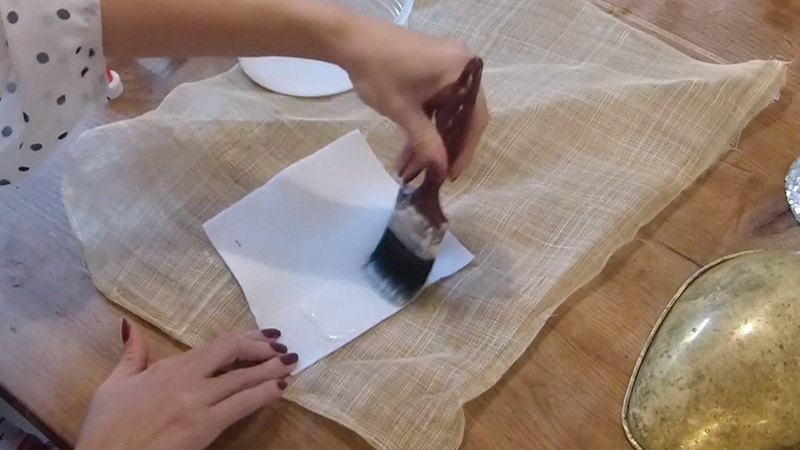
Creating fabric stiffeners at home using readily available ingredients is a cost-effective and versatile approach for crafting and sewing enthusiasts.
Here are some DIY methods for fabric stiffening at home:
Homemade Starch Solution
Creating a homemade starch solution is a straightforward method for stiffening fabric. Begin by dissolving 1-2 tablespoons of cornstarch or potato starch in a cup of cold water, ensuring a smooth mixture.
Next, add this mixture to a pot of boiling water while stirring continuously until it thickens. Let the solution cool before use. Submerge or spray the fabric with this starch solution and let it air dry.
As the fabric dries, it will gradually stiffen, providing structure for your sewing or crafting project.
White Glue and Water Mixture
Another DIY option involves using white school glue, such as Elmer’s, and water. Create a diluted adhesive by mixing equal parts white glue and water.
Stir until the solution is well combined. Apply this mixture evenly to the fabric by brushing or spraying it. After the glue-water mixture dries, the fabric will stiffen, making it ideal for various creative projects.
Gelatin Solution
Unflavored gelatin can be used as a fabric stiffener. Begin by dissolving one packet of unflavored gelatin in a cup of hot water and stirring until it completely dissolves.
Submerge the fabric in the gelatin solution, ensuring it’s thoroughly coated. Allow the fabric to air dry, and as the gelatin sets, it will provide stiffness to the fabric.
Sugar Water Solution
Create a fabric stiffener using common household sugar and water. Prepare a saturated sugar solution by dissolving sugar in hot water. Immerse the fabric in the sugar water solution, ensuring it’s fully saturated.
Let the fabric air dry, and as the sugar solidifies, it will leave the fabric stiff and ready for your crafting or sewing project.
Heat-activated Adhesive Interfacing
For a method akin to commercial fusible interfacing, layer adhesive webbing between two fabric pieces and cover them with parchment paper. Use a hot iron to activate the adhesive and bond the fabric layers together.
This approach allows you to customize the stiffness level based on the amount of adhesive used.
Double-layering With Lightweight Fabric
When you need extra stiffness, consider sewing or bonding two layers of lightweight fabric together. This creates a thicker, stiffer material that can be especially useful for certain crafting or sewing projects.
Natural Stiffeners
For an eco-friendly approach, explore the use of natural substances like egg whites, milk, or rice water as fabric stiffeners. While these may not provide as much stiffness as some other methods, they offer a sustainable alternative for those seeking a greener option.
What Are Some Commercial Fabric Stiffeners?
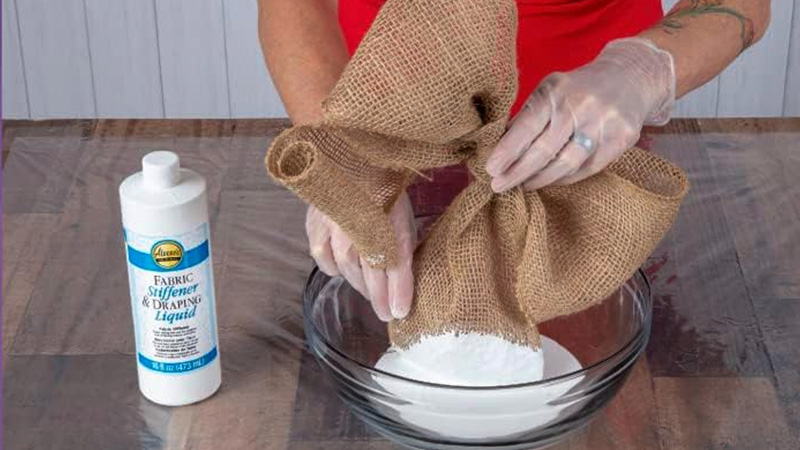
Commercial fabric stiffeners are widely available products designed to enhance the structure and rigidity of fabrics for sewing, crafting, and various creative projects. They offer convenience and consistency, making them popular choices for those looking to achieve specific levels of stiffness in their materials.
Here are some common commercial fabric stiffeners:
Sta-flo Liquid Starch
Sta-Flo Liquid Starch is a trusted and widely used product for fabric stiffening. It comes in a liquid form that can be diluted with water to achieve the desired level of stiffness.
This versatile stiffener is known for its ease of use and affordability, making it a favorite among sewists and crafters. It dries transparent, leaving fabrics with a crisp and structured finish, making it ideal for projects that require a neatly defined appearance.
Aleene’s Fabric Stiffener and Draping Liquid
Aleene’s Fabric Stiffener and Draping Liquid are specially formulated for fabrics like lace, muslin, and silk. This product allows for the shaping and draping of fabric while maintaining a sturdy and stiffened structure.
It is a valuable choice for projects that demand delicate and intricate fabric manipulation, ensuring the desired design holds beautifully.
Mary Ellen’s Best Press Starch Alternative
Mary Ellen’s Best Press is a starch alternative that is beloved for its lightweight, non-flaking formula. Available in various delightful scents, it can be sprayed directly onto fabric before ironing.
This product is cherished by quilters and sewists for imparting a fresh and crisp finish to their creations.
Terial Magic Fabric Stabilizer
Terial Magic Fabric Stabilizer stands out for its transformative capabilities. When sprayed on fabric, it turns the material into a paper-like substance, making it a go-to choice for fabric origami, quilting, crafting, and any projects that require fabrics to maintain rigid shapes with ease.
Mod Podge Stiffy Fabric Hardener
Mod Podge Stiffy Fabric Hardener is designed for fabric sculpting and molding. It provides the necessary rigidity for shaping fabric into rigid forms, making it an essential tool for artists and crafters who work on fabric-based sculptures and unique craft projects.
Pellon Fusible Interfacing
Pellon offers a range of fusible interfacings in various weights and stiffness levels. These interfacings can be ironed onto specific areas of fabric to add structure and stability, making them ideal for reinforcing collars, cuffs, waistbands, and other sewing projects.
Dritz Fabric Stiffener Spray
Dritz Fabric Stiffener Spray is a convenient choice for fabric stiffening. Packaged in a spray bottle, it simplifies the application process. This product dries clear and is suitable for a wide range of fabric types, making it versatile for crafting and sewing needs.
Scotchgard Fabric Stiffener
Scotchgard offers a fabric stiffener designed to help fabrics maintain their shape and resist wrinkles. It adds durability and structure to fabrics, making them suitable for various applications, including home decor and crafting projects.
Krylon Make It Last Clear Sealer
Although primarily a clear sealer, Krylon Make It Last can be applied lightly to fabric to enhance its rigidity. It is commonly used in fabric-based crafts and decorations, helping fabrics maintain their desired shape.
Acrylic Fabric Stiffeners
Several brands produce acrylic-based fabric stiffeners, which can be brushed or painted onto fabric for added stiffness and shape retention. These stiffeners are particularly valuable for artists and crafters creating fabric sculptures and art pieces.
FAQs
While it’s possible, it’s usually more effective to stiffen the fabric before sewing to ensure even application and prevent potential damage to the finished project.
Yes, you can experiment with homemade stiffeners like a mixture of equal parts water and white glue or gelatin dissolved in water. These alternatives can be cost-effective and work well for certain projects.
Fabric stiffeners work best on natural fibers and some synthetic fabrics. Delicate or very sheer fabrics may require specialized stiffening techniques or may not be suitable for stiffening.
Store stiffened fabric flat or on a hanger to prevent wrinkles and maintain its shape. Avoid folding it for extended periods, as this can lead to creases.
Washing stiffened fabric can remove the stiffness. If you need to clean a project made with stiffened fabric, consider spot cleaning or dry cleaning to preserve its rigidity.
To Recap
Mastering the art of fabric stiffening opens up a world of creative possibilities for sewing enthusiasts and crafters alike. This essential technique empowers individuals to transform soft, pliable textiles into structured, well-defined materials, enhancing the quality and durability of their projects.
Whether you’re fashioning tailored clothing, crafting intricate accessories, or embellishing home decor items, the choice of stiffening method allows you to tailor your fabric’s rigidity to suit your vision.
By following the appropriate steps and selecting the right materials, you can achieve the desired level of stiffness, ensuring that your sewing projects not only retain their intended shape but also exude a professional finish.
Fabric stiffening is a versatile tool that empowers you to bring your creative ideas to life with precision and style.
Leave a Reply